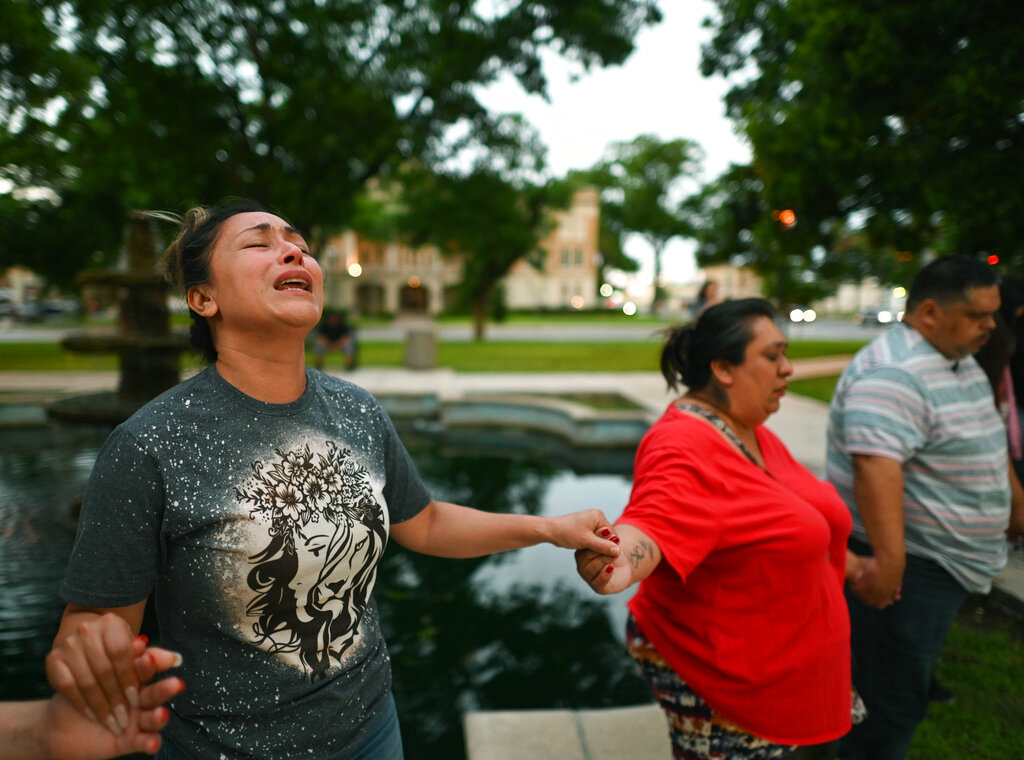
In the aftermath of the second deadliest school shooting in U.S. history, national safety experts said the way to make campuses safer was not just bulletproof doors, active shooter drills or security cameras, but better mental health treatment to keep troubled people from becoming killers.
Experts note that most shooters broadcast their deadly intentions on social media or through communications to friends and family before their violent sprees. The key is to stop them and get them help — not to initiate another debate on gun laws or arming teachers.
“We’ve been struggling with this for 20 years,” said Amy Klinger, director of the nonprofit Educator’s School Safety Network in Genoa, Ohio. “When one of these events happen everyone retreats to their corners and starts yelling about guns … instead of the one thing we can agree on: we don’t want kids to die.”
Nineteen children and two adults were massacred by an 18-year-old shooter Tuesday, May 24, at Robb Elementary School in Uvalde, Texas. The only school shooting that took more lives was the Sandy Hook rampage in Connecticut in 2012, with 26 victims.
The alleged killer in the Texas shooting was Salvador Ramos, who critically shot his grandmother in the head and texted a female friend of his plans to “shoot up” an elementary school.
Texas school shooting
From Columbine to Robb, 169 shot dead in US schools
The victims: Relatives, educators remember those killed in Texas school shooting
Gunman kills 19 children in Texas school rampage
Ramos in the days before the rampage, sent a friend a photo of an assault rifle and ammunition. Experts say these are the types of red flags school personnel, parents, school mates and others should be trained to identify and report.
Students need to be assured that by telling authorities they are saving their friends and not snitching, said Ron Astor, an internationally recognized school safety expert at UCLA.
In Orange County, the Intelligence Assessment Center — managed by the sheriff’s department — proactively monitors social media and connects school resource officers so information can be shared across the county. But tips, especially from family members or associates, are key to preventive actions.
Many other counties have such assessment centers.
California law also requires schools to have a comprehensive safety plan, but most are inadequate and out of compliance, experts said. Many plans are merely cut and pasted from previous years, they said.
“There is the mentality that it will never happen here,” said William Jeynes, author of the book, “Reducing School Shootings” and an education professor at Cal State Long Beach.
Precious resources should be spent on establishing networks in the community to identify red flags and on providing mental health treatment at school. Most school psychologists deal largely in assessing students for special needs classes and not for treatment, experts said.
Some security experts argue — with support from parents — that schools need more hardware, like surveillance cameras or metal detectors.
“Common sense would say we want to arm teachers, or put dogs in schools or metal detectors. I understand that instinct,” Astor said. “But research shows when you do that it has long term effects on kids. It makes them feel more scared, like they’re in prisons.”
“The hardware and the drills make students feel super anxious,” he said. “The more you have the more you turn the schools into a fortress and there is no evidence it works.”
Added Klinger: “There is no foolproof way to put a school in a bubble … if determined, an attacker will be most likely to get in.”
What works are strategies such as reducing the instances of bullying at schools, getting help for the attacker and the victim, according to experts.
“It’s not the bully that ends up pulling the trigger, it’s the kid who was bullied,” said Eric Rosoff, a former Burbank Police officer and head of the Burbank-based consultant, Campus Safety Group.
Related Articles
Laguna Woods church shooting adds to history of hate, but hope isn’t lost
Pedestrian struck and killed on 55 Freeway in Tustin
Ex-Orange County jail inmate gets $500,000 for work assignment injury
Coastal fire in Laguna Niguel now 100% contained
Did Laguna Woods church’s support for Taiwan independence factor in shooting?
One of the solutions is to establish a connection between students and their schools, make them feel as if they belong, experts said. They pointed out that the school shootings are sometimes a form of suicide.
Said Scott Poland, co-director of the Suicide and Violence Prevention Office at Nova Southeastern University in Florida, “Schools should be a place kids like, not a place they feel like blowing up or killing.”
